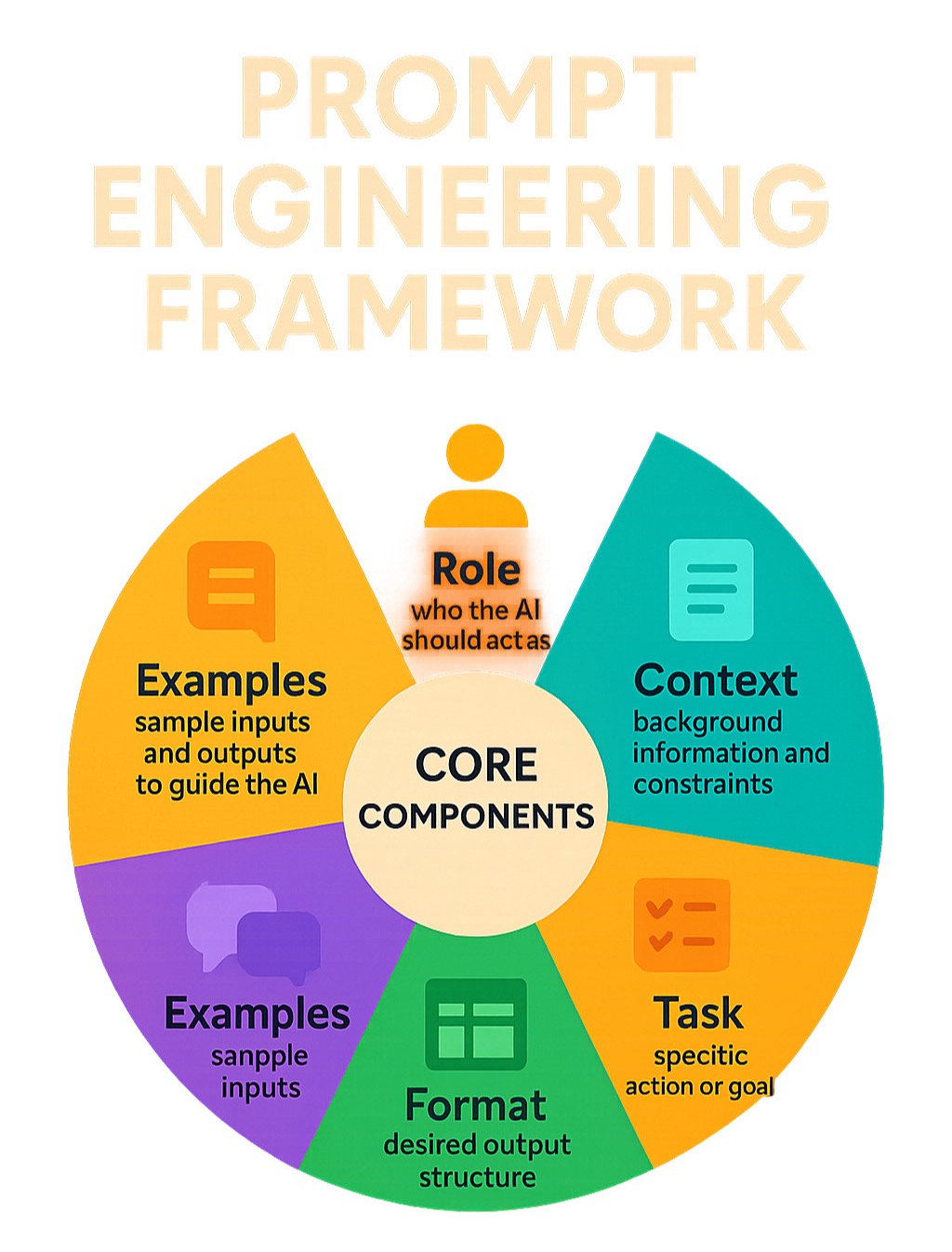Framework Frenzy: Your Guide to Prompt Engineering Success
From Simple Questions to Strategic Commands.

A prompt engineering framework is a structured method for crafting effective AI prompts using components like role, context, task, and format. These frameworks turn random trial-and-error into a systematic approach for better, more consistent results.
Quick Framework Overview:
- RISEN: Role + Instruction + Steps + End Goal + Narrowing
- CREATE: Context + Role + Example + Audience + Tone + End Goal
- CO-STAR: Context + Objective + Style & Tone + Audience + Response
- C.O.R.E.: Context + Objective + Role + Example
- P.A.R.A.: Problem + Analysis + Recommendation + Action
Remember when asking ChatGPT to "write a blog article about yoga" yielded bland, generic responses? The problem wasn't the AI—it was the prompt.
Prompt engineering has evolved from a solo skill into a collaborative craft. What started as random experimentation has become a structured discipline. As Kyle Balmer from the promptentrepreneur TikTok channel puts it: "If you are able to talk to your friends on WhatsApp, then you are able to talk to AI."
The difference is like asking someone, "Help me," versus giving them a detailed brief with context and goals. One gets you confused stares; the other gets results.
Large language models can produce any sequence of characters, from lukewarm responses to the first section of a bestselling novel. The quality depends entirely on how you ask.
Successful AI practitioners don't wing it; they use systematic approaches to guide AI toward specific, valuable outputs. These frameworks are practical tools companies use to scale customer support, create content, and solve complex problems.

The Foundations: Core Principles of Effective Prompting
Think of prompt engineering like giving directions. You wouldn't just say "meet me later" and expect a friend to show up at the right place and time. The same logic applies to AI. Every great prompt engineering framework builds on core principles that turn vague requests into clear instructions.
Specificity is your best friend. AI models aren't mind readers. Instead of asking "What do you know about climate change?", try "List three major causes of climate change, focusing on human activities." The more specific you are, the more focused your results will be.
Iteration is your secret weapon. Prompt engineering isn't about getting it perfect on the first try. It's about starting somewhere, analyzing the AI's output, spotting gaps, and refining your approach. This back-and-forth process is where the magic happens.
Context is crucial. Telling an AI to "explain quantum computing to a high school student" versus just "explain quantum computing" yields completely different responses. Background information helps the AI understand what you want and how you want it delivered.
Clarity keeps things simple and direct. Every word in your prompt should earn its place. Skip jargon unless it's necessary and get to the point quickly.
Role-playing and providing examples (few-shot learning) are powerful. Tell the AI to "act as a professional copywriter" and watch its tone shift. Show it examples of what you want, and it will understand your vision better, improving accuracy by 26% to 47%.
For deeper insights, OpenAI's guide to prompt engineering offers excellent additional guidance.

Structured vs. Unstructured Prompting
Knowing when to use structured versus unstructured prompts can make or break your results.
Structured prompts are for when you need controlled output with a clear goal, like writing a blog post or drafting marketing copy. You provide a clear framework (context, format, goals), and the AI delivers a predictable, professional result.
Unstructured prompts are best for brainstorming and ideation. A loose, conversational approach gives the AI more freedom, often yielding surprising insights and creative connections.
When to use each depends on your process. Need something specific and polished? Go structured. Looking for inspiration? Go unstructured.
Key Techniques to Lift Your Prompts
Once you have the basics, these techniques can transform good prompts into great ones.
Few-shot learning involves providing the AI with a few input-output examples to clarify the task. As mentioned, this can boost accuracy by 26% to 47%.
Zero-shot prompting is the direct approach: giving instructions without examples. This works well for simple tasks like summarization or translation where the AI's general knowledge is sufficient.
For complex reasoning, Chain of Thought (CoT) prompting is incredibly powerful. Instead of just the final answer, you ask the AI to think step-by-step. This is like asking someone to show their work and can improve AI accuracy by 50% to 100% for complex problems.
These techniques work together. You can use few-shot learning to show the AI what you want, then add CoT reasoning to ensure it thinks through each step carefully. These methods form the backbone of many successful prompt engineering frameworks.
A Deep Dive into the Best Prompt Engineering Frameworks
Think of prompt engineering frameworks as a workshop of specialized tools. You wouldn't use a sledgehammer for a delicate screw, and the same logic applies here. These acronym-based systems are practical tools designed to simplify AI communication.
Each framework is a mental checklist for effective prompting. The goal isn't finding the "perfect" one, but choosing the right tool for the job. Some excel at creativity, while others are better at analysis or problem-solving.
Frameworks are conversation starters that help you communicate your needs clearly to an AI, providing a roadmap that leads to better results.
Frameworks for Content Creation and Creativity
When crafting marketing copy or brand stories, certain frameworks balance creative freedom with the structure needed to hit your goals.
The CREATE framework is powerful for content creators. It guides you through Context, Role, Example, Audience, Tone, and End Goal. This prompt engineering framework is excellent for brand storytelling, ensuring content aligns with your audience and voice. It helps you think like a content strategist, providing the AI with a full brief for intentional, targeted content.
For emotionally engaging content, the D.A.R.E. framework focuses on Describing the scene, defining the Action, ensuring emotional Resonance, and Elevating the impact. It excels when you need content that truly connects with people.
Frameworks for Analysis and Problem-Solving
When you need AI to perform analysis or strategic thinking, different frameworks are required.
The RISEN framework turns AI into a strategic advisor by defining Role, Input, Scenario, Expectations, and Nuance. This guides the AI toward thoughtful analysis, perfect for thought leadership or market analysis.
For specific business challenges, the P.A.R.A. framework provides a solution-focused structure: Problem, Analysis, Recommendations, and Action. It excels at breaking down complex situations into actionable insights.
A Closer Look at the RISEN Prompt Engineering Framework
Let's get practical with Kyle Balmer's RISEN framework. It breaks down into five components: Role (persona), Instruction (core task), Steps (required components), End Goal (audience and outcome), and Narrowing (constraints like word count or tone).
A basic prompt like "Write a blog article about yoga" produces bland content. But with RISEN:
Act as a professional copywriter to write a blog article about yoga. Start with a really interesting hook to grab the attention of the reader. Give me three main body points, each with examples, and finish with a strong call to action to get people to subscribe to a newsletter. The end goal is to provide a blog article for intermediate yoga practitioners who are looking to improve their philosophical understanding of yoga and to help offer insights to their clients. The article should be between 500 and 750 words and be written in clear, accessible language. Also provide a prompt to request a suitable feature image to include in the article.
The difference is remarkable. The RISEN-powered output is focused, purposeful, and customized. It's like giving a detailed project brief instead of just asking for "help."
[TABLE] Comparing Popular Prompt Engineering Frameworks
Understanding which framework fits your needs can save time and improve results. Here's how popular options stack up:
| Framework | Best For | Key Components | Strengths |
|---|---|---|---|
| RISEN | Detailed, specific content generation | Role, Instruction, Steps, End Goal, Narrowing | Produces highly customized, non-generic outputs; excellent for targeted content needs |
| CREATE | Creative content marketing with precision | Context, Role, Example, Audience, Tone, End Goal | Balances creativity with structure; ensures brand alignment and audience focus |
| CO-STAR | Comprehensive prompt design across tasks | Context, Objective, Style & Tone, Audience, Response | Holistic approach covering all prompt dimensions; versatile for diverse outputs |
| RACE | Quick, clear task communication | Role, Action, Context, Expectation | Simple and effective for straightforward tasks; ensures clarity and defined outcomes |
The key insight is that there's no single "best" prompt engineering framework. The magic happens when you match the right framework to your specific goal.
Advanced Techniques and Applications
Once you master the basics, you can move from single prompts to building entire AI systems. This is where a solid prompt engineering framework becomes your secret weapon.
A game-changer is Retrieval Augmented Generation (RAG). Standard AI only knows what it learned during training. RAG fixes this by giving AI the ability to "look things up" in real-time from your documents, databases, or the internet.
Before answering, the AI searches for relevant, up-to-date information and combines it with its existing knowledge. This provides a comprehensive response, avoiding hallucinations or knowledge gaps. Imagine asking about yesterday's market trends or new company policies and getting accurate, current insights. RAG connects your AI to an intelligent search engine that feeds its reasoning process.

Automating and Scaling with Prompt Templates
For real AI applications, static prompts aren't enough. You need prompt templates—dynamic frameworks that adapt to different situations while maintaining consistency. Think of them as fill-in-the-blank forms for your AI, like "Hello [NAME], here's your personalized [PLAN_TYPE] plan."
This is crucial for automation and scaling. For tasks like generating personalized emails or analyzing documents, templates ensure every interaction follows your proven prompt engineering framework. This maintains a consistent tone, structure, and quality, even with different data.
At Potions, our platform is built on this concept. Every prompt is saved, versioned, and given a stable URL, turning prompting into a collaborative craft. Users can search hundreds of proven prompts, adapt them, and share improvements back to the community's growing library of AI expertise. More info about exploring AI prompts.
Applying Frameworks to Different AI Tasks
A well-designed prompt engineering framework is versatile. The same principles apply to text, code, image generation, or Q&A systems. You simply tailor the emphasis. For text generation, focus on tone and audience. For code generation, prioritize language and functionality. For image generation, detail visual styles. The core methodology of providing context, roles, and objectives remains constant.
Prompt Engineering for AI Safety and Ethics
Prompt engineering isn't just about better outputs—it's about getting safer, more ethical outputs. This is a shared responsibility.
By carefully crafting prompts, we can reduce harmful responses and mitigate bias. We can proactively guide AI by stating ethical boundaries or designing instructions for sensitive topics. Controlling AI behavior through prompting is powerful. Techniques like Chain of Thought prompting improve accuracy and provide transparency into the AI's reasoning, helping us spot and correct flaws.
The research on Chain of Thought reasoning helps make AI more reliable. Responsible AI development is built into good prompt engineering.
Frequently Asked Questions about Prompt Engineering Frameworks
Let's tackle the most common questions about structured prompting.
What's the difference between a prompt framework and a prompt template?
A prompt engineering framework is your methodology—a recipe for how to think about prompts. It provides the guiding principles and components to consider.
A prompt template is a fill-in-the-blanks worksheet based on those principles. It's the reusable structure you apply.
For example, a framework might say, "Always include a role and task." A template would be: "You are a [ROLE]. Your task is to [TASK]."
Frameworks guide how you think; templates guide how you write. At Potions, users turn proven frameworks into reusable templates for the community.
Do I always need to use a framework for my prompts?
Not always. For simple questions like "What's the weather like?" you don't need one.
Frameworks shine whenever you need more than a basic answer. They are most valuable for complex, multi-step tasks, ensuring consistent results where quality is critical. Unstructured prompting is still great for brainstorming, but for reliable, high-quality results, a framework transforms guesswork into a repeatable process.
How do I choose the right prompt engineering framework for my task?
There's no single "perfect" framework; it's about matching the tool to the job.
Start by analyzing your goal. For creative marketing content, use frameworks like CREATE or D.A.R.E. For business analysis, P.A.R.A. or RISEN are better suited. For highly detailed tasks, RISEN offers precision and control.
The secret is to experiment. Try different frameworks on the same task to see what works best. Over time, you'll develop an intuition for which approach fits different situations. On Potions, we see users constantly remixing frameworks to find their sweet spot.
If you're just starting, begin with a simple framework like C.O.R.E. or RACE. Get comfortable with structured prompting, then explore more complex options as your needs grow. The goal is to find the framework that makes your process easier and more effective.
Conclusion: Join the Collaborative Prompting Revolution
We've come a long way from asking for "something about yoga" and getting bland, generic responses. The secret to opening up AI's potential isn't magic—it's methodology, which we've found through exploring prompt engineering frameworks.
The shift from simple questions to strategic commands happens when we accept clarity, context, and iterative refinement. Whether using RISEN for detailed content or CREATE for marketing, structured approaches consistently outperform random trial-and-error.
Prompting is a communication skill that improves with practice and structure. Frameworks like P.A.R.A. and CO-STAR are proven methodologies for helping AI understand exactly what we need.
What's most exciting is that prompt engineering is evolving from a solo endeavor into a collaborative craft. The future isn't about starting from scratch with every prompt. It's about building on shared successes and collectively pushing boundaries.
Advanced techniques like RAG and prompt templates are already enabling AI systems to access real-time information and maintain consistency at scale. These are practical tools companies are using now.
At Potions, we're building the infrastructure for this collaborative revolution. Our platform makes prompt engineering community-powered and version-controlled. Every prompt is saved, versioned, and given a stable URL, so you can track what works, experiment freely, and build on others' findings.
You don't need to be an AI expert to benefit from expert-level prompts. Our community shares hundreds of proven frameworks and templates you can instantly search, remix, and improve. When you find a better way, you contribute it back to the growing library of AI expertise.
Prompt engineering isn't intimidating with the right tools and community support. Frameworks provide the structure, and collaborative platforms provide the acceleration, democratizing access to sophisticated AI.
The revolution is underway. The question isn't if AI will transform how we work, but if you'll help shape that change.
Start building your prompt library and join thousands of others who are finding that the best prompts come from collaboration, not isolation. Your next breakthrough might be just one shared framework away.